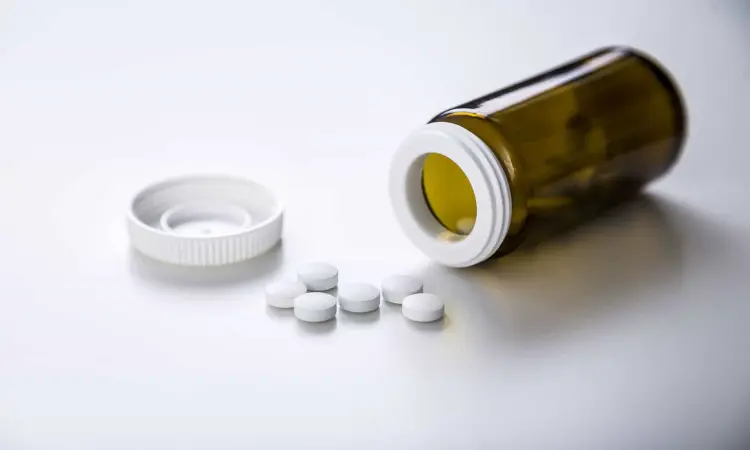- Home
- Medical news & Guidelines
- Anesthesiology
- Cardiology and CTVS
- Critical Care
- Dentistry
- Dermatology
- Diabetes and Endocrinology
- ENT
- Gastroenterology
- Medicine
- Nephrology
- Neurology
- Obstretics-Gynaecology
- Oncology
- Ophthalmology
- Orthopaedics
- Pediatrics-Neonatology
- Psychiatry
- Pulmonology
- Radiology
- Surgery
- Urology
- Laboratory Medicine
- Diet
- Nursing
- Paramedical
- Physiotherapy
- Health news
- Fact Check
- Bone Health Fact Check
- Brain Health Fact Check
- Cancer Related Fact Check
- Child Care Fact Check
- Dental and oral health fact check
- Diabetes and metabolic health fact check
- Diet and Nutrition Fact Check
- Eye and ENT Care Fact Check
- Fitness fact check
- Gut health fact check
- Heart health fact check
- Kidney health fact check
- Medical education fact check
- Men's health fact check
- Respiratory fact check
- Skin and hair care fact check
- Vaccine and Immunization fact check
- Women's health fact check
- AYUSH
- State News
- Andaman and Nicobar Islands
- Andhra Pradesh
- Arunachal Pradesh
- Assam
- Bihar
- Chandigarh
- Chattisgarh
- Dadra and Nagar Haveli
- Daman and Diu
- Delhi
- Goa
- Gujarat
- Haryana
- Himachal Pradesh
- Jammu & Kashmir
- Jharkhand
- Karnataka
- Kerala
- Ladakh
- Lakshadweep
- Madhya Pradesh
- Maharashtra
- Manipur
- Meghalaya
- Mizoram
- Nagaland
- Odisha
- Puducherry
- Punjab
- Rajasthan
- Sikkim
- Tamil Nadu
- Telangana
- Tripura
- Uttar Pradesh
- Uttrakhand
- West Bengal
- Medical Education
- Industry
Antenatal Opioid Exposure tied to smaller brain volumes in Newborn: JAMA

A U.S. prospective study has found that antenatal opioid exposure, particularly during the second or third trimester, was linked to smaller brain volumes in newborns. However the extent of impact varied based on the type and timing of opioid exposure. The study was conducted by Yao Wu and colleagues published in JAMA Pediatrics.
The prospective cohort study was performed between August 2020 and December 2023 at four U.S. sites and involved a total of 269 term newborns: 173 with antenatal opioid exposure and 96 unexposed controls. MRI scans were performed prior to the infants' age of 8 weeks, with a mean postmenstrual age of 42.84 weeks at imaging. 3D volumetric MRI was used without sedation, with harmonized protocols on Siemens and Philips 3T scanners. Automated segmentation with DrawEM and 3D U-Net pipelines was followed by manual corrections for accuracy.
Statistical analysis was performed using analysis of covariance (ANCOVA), controlling for important covariates such as postmenstrual age at MRI, sex, birth weight, maternal education, and pregnancy smoking.
Key Findings
The research found that opioid-exposed infants had significantly reduced brain volumes in almost all brain regions compared with unexposed controls.
Total brain volume:
• Exposed: 387.51 cm³
• Controls: 407.06 cm³
• Difference: 19.55 cm³ (95% CI, 8.75–30.35)
Cortical volume:
• Exposed: 167.07 cm³
• Controls: 176.35 cm³
• Difference: 9.28 cm³ (95% CI, 3.86–14.70)
Deep gray matter volume:
• Exposed: 27.22 cm³
• Controls: 28.76 cm³
• Difference: 1.54 cm³ (95% CI, 0.66–2.43)
White matter volume:
• Exposed: 159.90 cm³
• Controls: 166.65 cm³
• Difference: 6.76 cm³ (95% CI, 1.71–11.81)
Cerebellar volume:
• Exposed: 23.47 cm³
• Controls: 24.99 cm³
• Difference: 1.52 cm³ (95% CI, 0.67–2.36)
Brainstem volume:
• Exposed: 6.80 cm³
• Controls: 7.18 cm³
• Difference: 0.38 cm³ (95% CI, 0.19–0.57)
Amygdala volume:
• Left: 0.48 cm³ vs 0.51 cm³ (difference: 0.03 cm³)
• Right: 0.51 cm³ vs 0.55 cm³ (difference: 0.04 cm³)
Subgroup analysis demonstrated that:
• Methadone-exposed infants had significantly reduced white matter volumes compared to controls.
• Buprenorphine-exposed infants had a reduced right amygdala compared to controls.
• Infants exposed to opioids alone and polysubstance-exposed infants had significant volume decreases in the cortex, deep gray matter, cerebellum, brainstem, right amygdala, and total brain.
• Polysubstance-exposed newborns also had reduced white matter and left amygdala volumes compared to controls.
The study authors concluded that antenatal opioid exposure was found to be associated with lower global and regional brain volumes in neonates, as well as lower cortical, white matter, deep gray matter, cerebellar, and amygdala volumes. These observations highlight the susceptibility of the developing brain to in-utero opioid exposure and support proactive measures to counteract long-term neurodevelopmental effects.
Reference:
Dr Riya Dave has completed dentistry from Gujarat University in 2022. She is a dentist and accomplished medical and scientific writer known for her commitment to bridging the gap between clinical expertise and accessible healthcare information. She has been actively involved in writing blogs related to health and wellness.
Dr Kamal Kant Kohli-MBBS, DTCD- a chest specialist with more than 30 years of practice and a flair for writing clinical articles, Dr Kamal Kant Kohli joined Medical Dialogues as a Chief Editor of Medical News. Besides writing articles, as an editor, he proofreads and verifies all the medical content published on Medical Dialogues including those coming from journals, studies,medical conferences,guidelines etc. Email: drkohli@medicaldialogues.in. Contact no. 011-43720751


